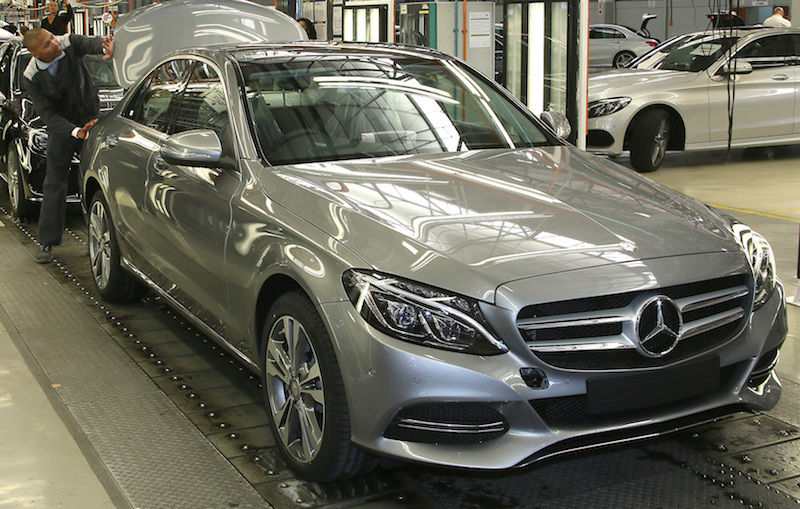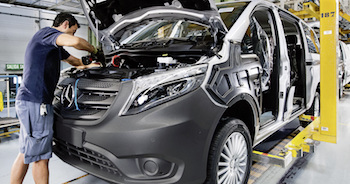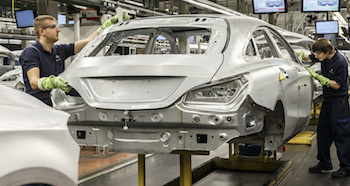While Mercedes has invested in and modernised its domestic plants, it is outside Germany where the most significant expansion of production has taken place
 Within Germany, Mercedes-Benz operates three car plants – Sindelfingen, Bremen and Rastatt – and two van plants – Düsseldorf, the main Sprinter plant, with special editions and conversions built at Ludwigsfelde near Berlin. All these factories have witnessed heavy investment in recent years, as have the company’s German plants that manufacturing engines, transmissions, chassis parts and stampings – such as €170m invested in the Kueppenheim factory for a new Schuler six-stage body press line in 2016. In addition, in nearby Hungary vehicle production continues to rise and to support rising Hungarian and German vehicle production, Mercedes will add an engine plant in Poland; this should come on stream in 2019, following investment of around €500m.
Within Germany, Mercedes-Benz operates three car plants – Sindelfingen, Bremen and Rastatt – and two van plants – Düsseldorf, the main Sprinter plant, with special editions and conversions built at Ludwigsfelde near Berlin. All these factories have witnessed heavy investment in recent years, as have the company’s German plants that manufacturing engines, transmissions, chassis parts and stampings – such as €170m invested in the Kueppenheim factory for a new Schuler six-stage body press line in 2016. In addition, in nearby Hungary vehicle production continues to rise and to support rising Hungarian and German vehicle production, Mercedes will add an engine plant in Poland; this should come on stream in 2019, following investment of around €500m.
While Mercedes has invested in and modernised its domestic plants, it is outside Germany where arguably the most significant investment and expansion of vehicle production has taken place; this is a continual process and at the end of July 2016, despite fears over a possible slowdown in the recovery of European car markets, Mercedes confirmed a second vehicle plant in Hungary. At present Mercedes operates a 180,000 units a year plant at Kecskemet, producing the front-wheel-drive B-class and CLA in sedan and estate or shooting brake formats. Mercedes will now add a facility to make both front- and rear-wheel-drive vehicles, in what the company says will be a highly flexible, digital factory built according to the principles of Industry 4.0, the protocol for the factory of the future. However, while modern, automated production technologies will be at the heart of this new plant, it will add another 2,500 jobs onto Mercedes’ Hungarian payroll, on top of the 4,000 the company already employs in the country.

It is too early to say which models will be made there, but model variants based on the MFA platform which underpin the B-class and CLA models already made in Hungary seem likely, as well as models based on Mercedes’ rear-wheel-drive platform, MRA. The new Kecskemet plant will, like the existing plant, operate in close co-operation with Mercedes’ plants in southern Germany and use a broadly similar supplier base in the region. Mercedes’ Hungarian operations will have received total investment of more than €1.5bn but the time the new plant comes on stream.
There is also a network of CKD assembly operations in Asia, notably in India and Vietnam, while the V-class is re-assembled from Spanish-made parts at Ladson, South Carolina for the North American where it is sold as the Metris. Full manufacturing of the Metris in the US in the long run should not be ruled out; the dis-assembly and re-assembly route was adopted for the Sprinter in the early years of its sale in the US – and as noted below, this is now moving to an all-new full manufacturing facility.
Mercedes also has a history of using contract manufacture to boost production when its own plants were unable to meet demand. To reduce its dependence on Germany, balance exchange rate issues and avoid punitive import duties, Mercedes has gradually expanded its global production network
Mercedes also has a history of using contract manufacture to boost production when its own plants were unable to meet demand. For example, in 2012, Mercedes sub-contracted production of 100,000 A-class vehicles over a five year period to Valmet in Finland; this contract finishes during 2016 and will be replaced by production of some GLC SUVs owing to capacity constraints in Bremen. To produce the GLC from early 2017, Valmet has installed 250 ABB robots in a major modernisation programme. This is reported to be the largest ever installation of robots in Finland’s manufacturing sector. Meanwhile, the venerable G-Wagen is still made by Magna Steyr in Austria, while around 12,000 R-class estate-MPV crossovers, only sold in China, are assembled by AM General in South Bend, Indiana. This factory made the original Humvee military vehicles; production of the R-class moved out of the Tuscaloosa plant to allow it to concentrate on the C-class and SUVs. While Chinese demand justifies continued R-class production, volumes do not justify the costs of shipping tooling and dedicated production equipment to China. A production JV with Nissan will see models such as the A-class, CLA and GLA – and probably other derivatives – made at a new facility on Nissan’s Aguascalientes site in Mexico:; Infiniti models, also based on the A-class, are expected to roll off this line in early 2017, with Mercedes models a year later.
This review now looks at the recent investment and expansion in the various Mercedes plants outside Germany and Hungary, and concentrates on the full manufacturing facilities, rather than the numerous CKD facilities in Asia.
SpainVehicles have been made in Vitoria for over 60 years, with Auto-Union owning the plant back in the 1950s; Mercedes took over the factory in 1981. In the last year significant new investment has been brought on stream at the factory which makes both conventional vans (Vito) and passenger versions (Viano/V-class), the latter increasingly commonly used as taxis in London and Paris especially, and as premium, executive shuttle buses worldwide. The factory is a world plant, supplying markets across the globe, as well as being the lead plant for V-class production in China. Total investment in Spain for the new models is €190m, with €41m invested in 2016 to expand the body shop, paint shop and the final assembly line; a third shift comes on stream October, raising production to c660 vehicles a day, up from 540 a day on the current two-shift system. Annual production could reach 137,000 units.
The expansion of production capacity in Spain has not been entirely problem-free; the flexible shift system which Mercedes is deploying here, with shift lengths reportedly varying from five to ten hours depending on fluctuations in demand, has not been welcomed unreservedly by the unions. One other interesting aspect of the investment in the plant is that Mercedes has contracted all internal logistics there – including the delivery of components to the assembly line – to DHL; and on the manufacturing technology front, Vitoria is understood to be the first plant within the Mercedes network to use LED-based technology to carry out automatic paint inspection.
South AfricaMercedes has used its factory in East London to supply the local market, much of the rest of sub-Saharan Africa and other southern hemisphere markets with C-class models since the early 2000s. At this time, the factory switched from a basic CKD operation to a full manufacturing plant. Capacity has been 60-70,000 units a year since this time and while the factory has periodically suffered labour disruption, with consequential occasional threats that Mercedes would pull out of the country. However in 2013, and not longer after another burst of labour unrest, Mercedes committed to a US$302m investment for production of the latest C-class. This investment was accompanied by a commitment to add a third shift to the factory and raise capacity to 100,000 units a year.
This expansion was described by the South African government in 2014 as the biggest single investment by a car company in the country since the country’s Automotive Investment Scheme began in 2009. Expansion at East London has seen an additional 550 jobs created at the plant and more in the supply chain; 10 new suppliers won contracts on the new models, three of whom deliver on a sequenced basis. Most of these operations are subsidiaries of major international companies, including IAC which built a new interiors plant to supply the Mercedes factory.
Two years later and the success of this investment was clear from suggestions by the local Mercedes CEO that further production contracts could be awarded to the East London plant, as well the start of local production of a plug-in hybrid version of the C-class, the C350e. Installing dedicated equipment for hybrid vehicle assembly and adjusting the international supply chain to support this confirms the centrality of the South African plant to Mercedes’ long-term global manufacturing plans. In addition, and in contrast to the situation in Brazil as noted below, Mercedes is expected to expand production at its sister truck plant in the country to take advantage of growing regional demand for commercial vehicles.
The East London factory does more than supply C-class sedans for the local market, with a significant number of models exported to right-hand drive markets worldwide, such as Australia, New Zealand and Japan. Highlighting the flexibility of this plant and its integration into Mercedes’ production network, some C-class models have also been shipped to the UK when capacity in Germany is fully utilised.
USThe Tuscaloosa plant in Alabama was Mercedes’ first full manufacturing plant outside Europe and opened in the mid-1990s making the first generation M-class SUV ; it is now home to the M-class’ successor, the GLE, and the larger GLS, as well as the C-class, the most global of Mercedes’ models which is made on four continents. The Tuscaloosa plant is started life making c70,000 units a year and now has capacity for over 300,000 units a year. The recent addition of the C-class and the expansion of the SUV range made at the plant has led to a new influx of suppliers and expansion of existing suppliers near the factory, including: Toyota Boshoku which opened a new interiors plant in 2015; Metalsa is expanding an existing plant to produce hot-formed structural components; Indian company SMP (which took over the former Peguform operations) is building a new plant for bumpers and door panels; and Eissmann is expanding an existing facility for interior parts and shifter modules.
Mercedes’ second vehicle plant in the US is in Charleston, South Carolina where US$500m is being invested. A separate facility at Ladson, South Carolina, is responsible for the local re-assembly of the V-class as the Metris. In addition, there is a JV plant with Nissan at Decherd in Tennessee which produces Mercedes engines – using a Nissan-designed assembly line – for the US-made C-class and the Infiniti Q50 vehicles; blocks, heads and crankshafts for these engines are imported from Germany
ChinaHaving been making C-class and E-class models for the local market for some time, during 2015 Mercedes added GLA and GLC production to its joint venture plant, Beijing Benz. Production capacity there is over 250,000 units annually. When the GLC started production in October 2015, Mercedes announced that China had become the brand’s largest market for both SUV models. Notably, the GLC has a local Chinese content of close to 60%, including Chinese-made 4- and 6-cylinder engines. Production systems and equipment installed at the Beijing facility for the C-class mirror those at the Bremen plant and include over 800 robots in the body shop. The GLA and GLC started production in Beijing in 2015 and in June 2016 the latest E-class LWB started production there; Beijing is the only place where the LWB model is made. In addition, there is a joint venture plant in China, at Fujian, which started producing the new Vito in 2016, following its manufacturing launch in Spain.
BrazilA new passenger car plant came on stream in March 2016, when a C-class rolled off the new Mercedes assembly line at Iracemapolis near Sao Paolo. The GLA SUV will be produced there from later this year as well. This is a small plant, with an initial capacity of just 20,000 units a year, following an investment of 600m Reals (US$167m). Initially, production on a single-shift basis will be only around 12,000 units a year. Mercedes will – for now – only sell Brazilian output locally; in the long run, exports are possible, but this will depend on exchange rates. JLR is adopting a similar policy with its new Brazilian plant, but BMW has decided to add exports of the X1 from its factory in Brazil. BMW began shipping vehicles to the US from BMW Brazil in July; Mercedes is unlikely to export to the US from Brazil in the near term as the models it makes in Brazil are already, or will soon be, made in the US or Mexico for the North American market. However, from a small beginning, bigger things will no doubt come for Mercedes Brazil as the plant has, according to Markus Schaefer, Mercedes-Benz cars board member for manufacturing and logistics, been designed to make any model on a Mercedes platform, front- rear- or even all-wheel drive and with transverse- or longitudinally-mounted engines. He added that no other plant in the group was so flexible.
 Mercedes operates a 180,000 units a year plant at Kecskemet, Hungary, producing the front-wheel-drive B-class and CLA in sedan and estate or shooting brake formats
Mercedes operates a 180,000 units a year plant at Kecskemet, Hungary, producing the front-wheel-drive B-class and CLA in sedan and estate or shooting brake formatsThe Brazilian factory has begun by producing vehicles in a manner which sites between full manufacture and a CKD operation. The aim is to move to full manufacture as soon as possible. Initially C-class bodies have arrived in Brazil welded and painted (this is the same as takes place at JLR’s factory in Brazil). However, when the GLA comes on stream later in 2016, the plant’s body welding and paint shops – for both models – will also become operational, as will several additional local suppliers. Body stampings will continue to be imported from Germany as the low volumes do not justify the installation of presses in Brazil and certainly do not support the cost of a duplicate set of press tools. Some of the major sub-assembly work has also been contracted out to suppliers; for example, ZF’s Brazilian operation assembles the engine, transmissions, radiator and axles at a plant 130kms from the Mercedes factory, with the finishing work for these assemblies carried out – by ZF staff – within the Mercedes complex. Numerous other global suppliers have also won contracts to supply this plant, such as Lear which delivers fully-assembled seats.
While the production of cars and SUVs in Brazil appears to be buoyant and progressing well, for Mercedes’ truck operations the situation is not so positive; at the end of May 2016, 1800 workers at the company’s truck and bus plant in Sao Paolo were put on indefinite paid leave, with the company looking for 2,000 voluntary redundancies in the light of declining commercial vehicle demand.
In conclusionFor many years, Mercedes had made the vast majority of its vehicles in Germany and exported to the rest of the world. However, in order to reduce its dependence on high-cost Germany, to balance exchange rate issues and avoid often punitive import duties on fully built vehicles in many markets, Mercedes has gradually expanded its global production network. With over 250,000 vehicles a made in each of the US and China, over 100,000 in each of Spain and South Africa, and soon more than 300,000 to be made in Hungary, Mercedes is already approaching 1m vehicles a year made outside Germany; and it will soon exceed that 1m threshold, a quite remarkable transformation which sees no sign of stopping.






































